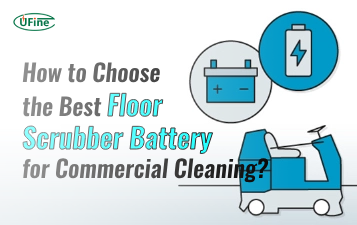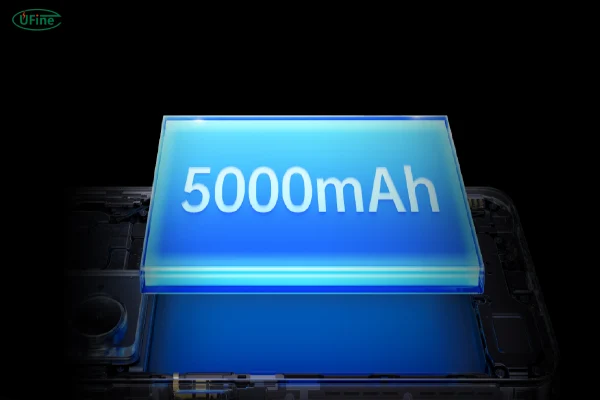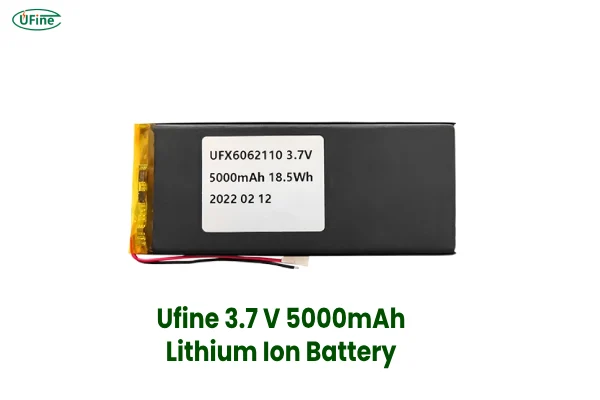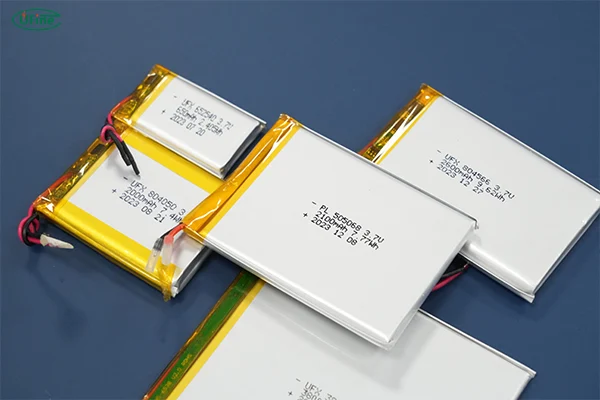Part 1. Understanding mAh
Before we can talk about a 5000mAh battery, we need to understand the unit itself: mAh, or milliampere-hours.
Think of it as a fuel tank. Just like how a car’s tank holds a certain number of liters of gas, a battery holds a certain number of milliampere-hours of electric charge. So, a 5000mAh battery can deliver 5000 milliamps for one hour, or 1000 milliamps for five hours, and so on.
But here’s the catch—how long that battery lasts entirely depends on how much power your device draws. That’s why a 5000mAh battery in a flashlight might last days, while in a power-hungry drone, it might die in under 30 minutes.
Part 2. Rechargeable vs non-rechargeable 5000mAh batteries
Not all 5000mAh batteries are created equal. In fact, the difference between rechargeable and non-rechargeable is massive in terms of use, cost, and environmental impact.
Rechargeable 5000mAh Batteries
These are found in:
- Smartphones
- Drones
- RC cars
- Laptops
- Power banks
- Flashlights
- Power tools
Types include:
- Li-ion (Lithium-ion): High energy density, widely used, long lifespan
- LiPo (Lithium Polymer): Lightweight, flexible shapes, common in drones and RC gadgets
- NiMH (Nickel-metal hydride): Safer, used in household rechargeable AA/AAA batteries
If you’re looking for custom battery solutions—including LiFePO4, Li-ion, ultra-thin, high-rate, or high-temperature batteries, Ufine Battery can design and manufacture the exact battery your product needs.
Non-Rechargeable 5000mAh Batteries
These are rare and mostly found in:
- Emergency gear
- Medical equipment
- Military devices
They offer long shelf life but can’t be reused. If you care about sustainability, rechargeable is the only way to go.
Part 3. How long does a 5000mAh LiPo battery last?
This is probably the most searched question around 5000mAh batteries—and for good reason. Whether you’re flying a drone or binge-watching Netflix, you want to know how long your battery will last.
The Formula:
Battery Life (hours) = Battery Capacity (mAh) ÷ Device Current (mA)
For example, if your drone draws 2500mA:
5000 ÷ 2500 = 2 hours
But wait—it’s not that simple. In the real world, several factors affect battery performance:
- Temperature
- Internal resistance
- Efficiency of your device
- Battery age
So in most real-world cases, expect 80-90% of the theoretical runtime.
Pro tip:
Devices with screens or motors (like phones or drones) usually burn more power. For a phone, a 5000mAh battery might get you 8-10 hours of screen-on time. For a drone, maybe just 20–30 minutes of flight.
Part 4. How long does it take to charge a 5000mAh battery?
Charging time is just as important as battery life—because when you’re low on juice, every minute counts.
The Formula:
Charge Time (hours) = Battery Capacity (mAh) ÷ Charging Current (mA)
If you’re using a 2A (2000mA) charger:
5000 ÷ 2000 = 2.5 hours
But again, real life isn’t that straightforward. Factors that influence charging time:
- Battery chemistry (Li-ion vs LiPo vs NiMH)
- Charger efficiency
- Battery health
- Charging temperature
- Built-in protection circuits
Fast chargers may reduce time to under 2 hours, but they can generate heat and reduce long-term battery life if overused.
Part 5. What to look for when buying a 5000mAh battery
So you’ve decided to buy a 5000mAh battery. Awesome! But which one? Let’s break it down.
- Voltage (V) – Make sure the voltage matches your device. Using the wrong voltage can damage both battery and device.
- Battery Chemistry – Li-ion for general use, LiPo for drones or RCs, NiMH for household items.
- Discharge Rate (C rating) – Higher C rating means more power delivery. Important for high-drain devices like drones.
- Recharge Cycles – Look for 300–500+ cycles. Some premium models offer 1000+.
- Size & Dimensions – A 5000mAh 21700 won’t fit where a 18650 fits. Always check the fit!
- Connector Type – XT60, JST, USB-C? Get the right connector or you’ll need adapters.
- Brand Reputation – Avoid unknown brands. Stick with names like Panasonic, Samsung, LG, or trusted RC battery makers.
Part 6. 5000mAh 21700 vs 18650 vs 26650 battery: what’s the difference?
These numbers refer to battery size, not capacity.
| Battery | Size (mm) | Typical Capacity | Notes |
|---|---|---|---|
| 18650 | 18 x 65 | 2000–3500mAh | Small, reliable, but limited capacity |
| 21700 | 21 x 70 | 4000–5000mAh | Balanced size and power, popular in EVs |
| 26650 | 26 x 65 | 5000–6000mAh | Bulkier but higher capacity |
If you need a compact battery with decent capacity, go for 21700. If size isn’t a problem and you want maximum power, 26650 is your best bet.
Part 7. What affects the lifespan of a 5000mAh battery?
Battery degradation is real. A brand-new battery might give you a full day of use, but six months later? Not so much.
Here’s what hurts battery life:
- Overcharging or deep discharging (e.g., dropping below 0%)
- Fast charging too often
- Extreme temperatures
- Leaving the battery unused for too long
- Mechanical damage
- Poor-quality chargers
Batteries are like us—they don’t like stress, extreme conditions, or being ignored.
Part 8. How to extend the life of your 5000mAh battery?
Want your battery to last years, not months? Follow these practical tips:
- Keep charge between 20% and 80%. Full 100% charges or 0% drops wear it down.
- Avoid heat. Don’t charge in direct sunlight or next to hot electronics.
- Don’t leave it charging overnight every time.
- Use slow chargers occasionally to reduce stress.
- Store at 50% if not used for weeks.
- Avoid full discharges.
These habits may seem small, but they make a big difference over time. Your 5000mAh battery will thank you.
Part 9. Battery mAh scams
Ever bought a “5000mAh battery” that barely lasts an hour? You’re not alone.
Some shady manufacturers fake their ratings. They re-wrap old cells or lie on labels to make sales. These batteries often:
- Underperform
- Overheat
- Swell
- Even catch fire
How to avoid scams:
- Buy from trusted brands and sellers
- Check user reviews
- Use a USB tester to verify capacity
- Compare battery weight (fake ones are often lighter)
If it sounds too good (or too cheap) to be true—it probably is.
Buy from reliable manufacturers. Not sure who to trust? Ufine Battery has years of expertise in manufacturing custom lithium batteries that meet exact technical and environmental requirements.
Whether you need cylindrical batteries like 18650 or 26650, or ultra-thin cells for compact devices, Ufine Battery can create the perfect solution for you. Contact us today to discuss your needs.
Part 10. FAQs
Is a 5000mAh battery enough for a full day of phone use?
Yes—for most users, it lasts 1–1.5 days with moderate usage.
Can I use a 5000mAh battery in any device?
Only if the voltage, connector, and size match. Always double-check.
What’s better: 5000mAh Li-ion or LiPo?
Li-ion is safer and lasts longer. LiPo is lighter and has more power for high-drain devices.
How many times can I recharge a 5000mAh battery?
Usually 300–500 cycles. Higher-end batteries can go up to 1000+.
Can I leave my 5000mAh battery charging overnight?
Occasionally, yes—but not daily. It’s better to unplug when full.
Related Tags:
More Articles

How to Choose the Best Floor Scrubber Battery for Commercial Cleaning?
Selecting the ideal floor scrubber battery ensures a long runtime, rapid charging, and minimal maintenance for efficient commercial cleaning operations.
Battery for Blower vs Battery for Leaf Vacuum: Which One Should You Choose?
Battery for blower vs leaf vacuum—learn the key differences in power, fit, and runtime to choose the right battery for your outdoor tool needs.
How to Choose the Right Battery for Blower?
Choosing the right blower battery? Consider voltage, capacity, chemistry & usage. This guide helps match the best battery for peak performance.
How to Choose the Best Insulated Battery Box for Lithium Batteries?
Choosing the Best Insulated Battery Box for Lithium Batteries? Discover key factors such as size, material, and safety for optimal protection and performance.
7 Critical Elements on a Lithium Battery Shipping Label
What must be on a lithium battery shipping label? Learn 7 key elements to ensure safety, legal compliance, and correct handling across all transport modes.






